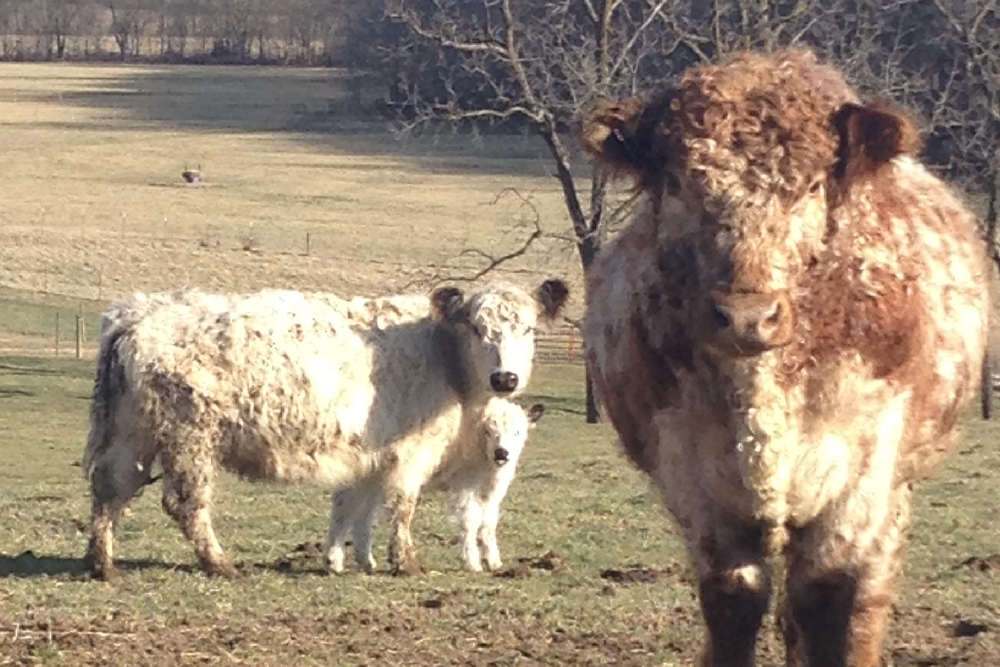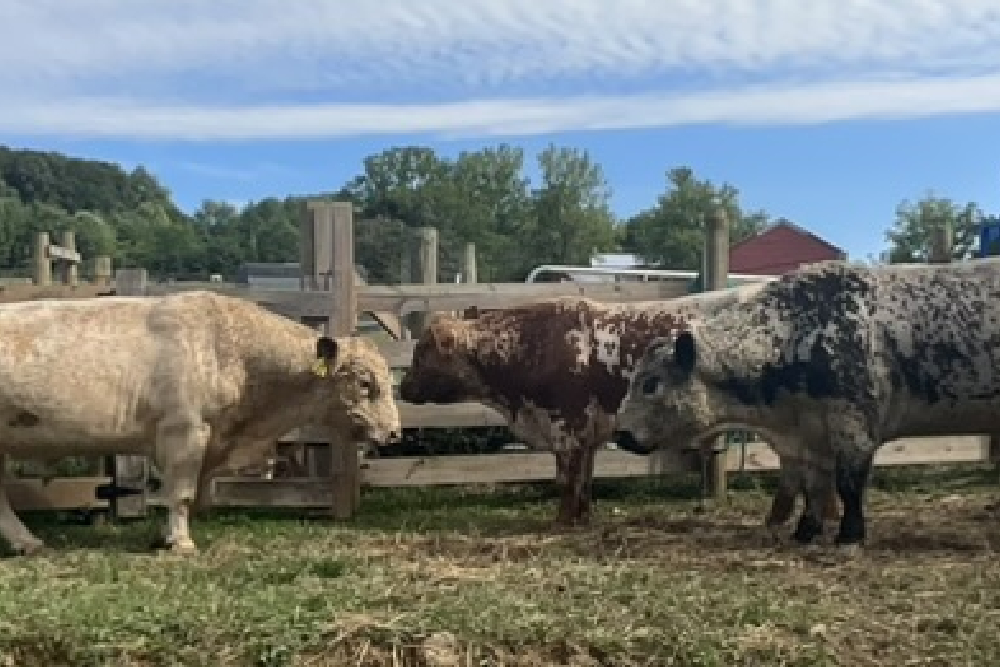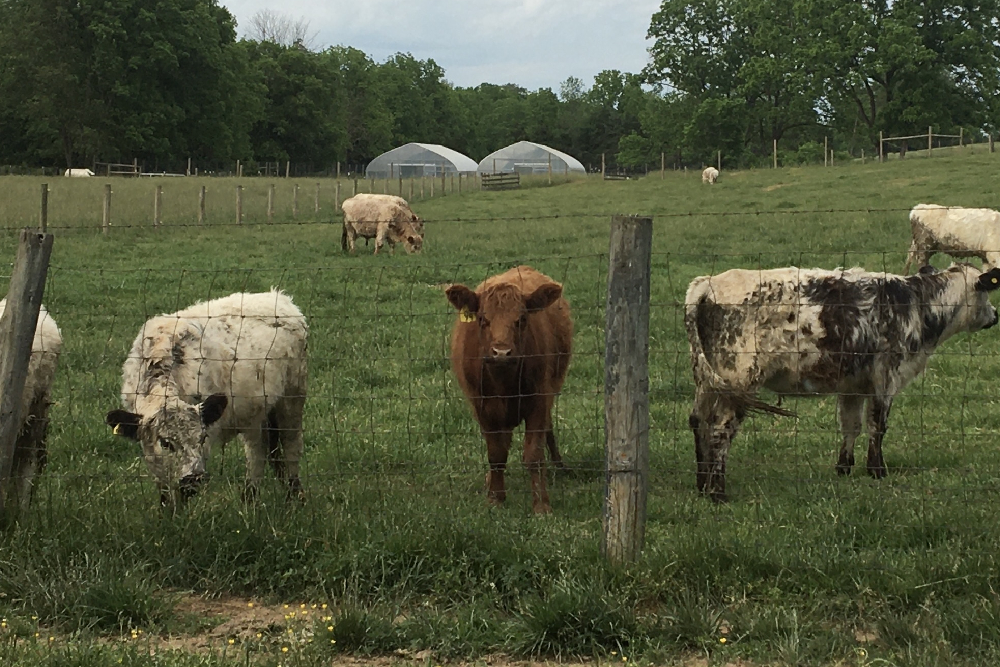100% Pureblood
Registered Galloway Cattle in Mid-Sized Miniture
Frequently Asked Questions
Miniature cattle have been widely developed and standardized in Australia and New Zealand for decades, but when we began breeding down in size for minis in the 1990s, there were no universally accepted mini standards in the United States and other parts of the world. After interest and demand for miniature cattle exploded in recent years, an effort was made to reach a general consensus on what the term “mini” means. The International Miniature Cattle Breeder’s Registry (IMCBR) is probably the most widely known and accepted authority on miniature cattle now, and it classifies animals as mini if their height at the rear hip is 48 inches or less at three years of age. It is important to note that there are two categories of mini cattle: mid-size miniature and micro mini. A mid-size miniature is between 42 inches and 48 inches at the rear hip at three-year maturity. A micro mini is less than 42 inches at the rear hip at three-year maturity.
Although they sound similar, it is important to know that these are three very different things. These have to do with bloodlines and breeding for all sizes of cattle. They have no bearing on whether a cow may be considered miniature.
Pureblood is also called full blood. Pureblood Galloway cattle have only registered, full blood Galloway cattle in their breeding history and absolutely nothing else. They must have at least five generations of full blood registration papers, or the cattle cannot be registered as pureblood.
Purebred cattle have parentage from a breed other than Galloway more than five generations back in their breeding history. This can be on either the sire’s or dam’s side. After five generations of pureblood breeding, these cattle are considered “purebred”. They can be registered and shown as purebred Galloways because by that point they are nearly all Galloway, but they are not technically 100% pure Galloway.
Graded Galloway cattle are those that have a breed other than Galloway less than five generations back in their breeding history. They may look very much like purebred Galloways depending on how much crossbreeding they have in their recent history, but they cannot be registered or shown as Galloway cattle. Because Galloways make excellent crossbreds and retain many Galloway characteristics after crossing, this is the most populous category of Galloway cattle. Most miniature cattle advertised as Galloways are graded.
It might seem straightforward on the surface, but when you drill down, you will probably discover that people have different conceptions about the meaning of “mini”, “registered”, “pure”, and even “cow”. Some clarification will be helpful no matter what size and breed you are considering.
First, there is no separate registry for miniature Galloways versus full-size Galloways in the United States. Pureblood and purebred Galloway cattle in the U.S. are all registered with the American Galloway Breeder’s Association, regardless of size. This is true for most breeds of cattle that have become popular as minis, not just the Galloway. A breed registry requires purebred lines proven to be a minimum number of generations back. The “registered” part of our home page description means that our cattle are registered with the American Galloway Breeder’s Association, with pedigrees on file five generations back.
In addition to breed registries, there are also various miniature cattle registries. These are meant to track all types and sizes of minis, and they help connect buyers with breeders. Registration with these sites is open to any minis that fit within size guidelines and is not strictly tied to breed or bloodlines. Miniature cattle on these sites tend to be registered as whatever breed they most reflect in physical appearance, but registration as a mini breed on these sites does not mean that they are purebred versions of the stated breed. The categorization simply helps buyers find minis with the look and size they want. Animals that are registered only with a mini registry and not with a breed registry are usually mixed breeds. When we say “registered”, we mean the breed registry proving they are 100% pure Galloway. We are not referring to a miniature cattle registry.
In the early days of miniature cattle development 25-30 years ago, mini meant a roughly 30% smaller version of the original breed that retained the same genetic makeup. The goal was to breed cattle that were easier to handle and required less pasture and forage than full-size cattle so that people with small hobby farms and just a few acres of land could raise them. Eventually, the craze for minis of any kind pushed breeders to go smaller and smaller until it became all about size at the expense of genetics. The focus of miniature cattle has shifted so far toward tiny that many people now think micros are the minis and mid-size minis are standard cows. When they think of a mini cow, they envision something that would fit in a large dog crate. When we say “mid-size miniature,” we mean the 42” to 48” mature height range defined in the IMCBR.
Micro minis have a place and fit a niche. We like them too, but our purpose was always to help preserve a rare and very old heritage breed from the threat of extinction. To the best of our knowledge, there is no such thing as a pureblood micro mini-Galloway in the United States at this time. Cattle are large animals, and you can only breed them down so small naturally. The only way to achieve a micro-mini size is by mixing breeds and incorporating dwarfism. This is why the tinier the cow, the less like a cow they usually look and the more out of proportion they tend to be. Pulmonary Hypoplasia with Anasarca (PHA) and Chondrodysplasia (Chondro) are the two most common genetic defects in micro mini cattle. Cattle with these genes may have a variety of health problems similar to those of miniature breeds of dogs. If both the sire and dam are chondro, it may be fatal to the offspring. It is possible to have cattle tested for chondro, and a negative test allows them to be sold as non-chondro. However, this doesn’t mean there is no chondro in their genetics. It only means that they are not considered a carrier that will pass the gene to their offspring when bred to another non-chondro. With the explosion in popularity of micro minis has also come an increase in scammers and fraudulent micro mini breeders. They prey on people’s confusion about what all these terms mean, the public ignorance about the health problems that genetic manipulation causes, and the lack of documentation required to register cattle in the various mini registries. There are certainly people who were sold a “purebred micro mini-Galloway” and who honestly believe that is what they own. We get phone calls and emails from people who are looking for a purebred micro mini-Galloway bull to breed with their heifer, but after careful questioning and review of their documentation it has always turned out their micros are mixed. When we say our cattle are 100% Galloway, that is exactly what we mean. There is no worry about chondro, PHA, or other micro mini genetic defects showing up in Idlehour mini-Galloways.
Galloways come in solid red, solid black, solid dun, and White Park. The White Park color is a solid white body with either black or red points (eyes, ears, nose, lower leg/feet) and sometimes flecking. Flecking can be light to heavy and tends to be concentrated around the front shoulders. We do not have the solid dun color which seems to be less common in the U.S, but it has always been a recognized Galloway color. The White Park color can be somewhat confusing because both red and black points are included in it, and the amount of flecking can make the cow seem more red or black than white. You can see examples of the possible color patterns (except dun) on our website.
It is important to note that White Park Galloways refers to a color pattern within the Galloway breed. There is also a breed of cattle called White Park, which has the same white body color with black points, but that’s where the similarities stop. The White Park breed is a very old English horned breed. Galloways are a naturally polled Scottish breed.
It is a common misconception that Galloways are belted. There are indeed Belted Galloways that look like Oreo cookies, but these are a separate and distinct breed from the heritage Scottish Galloways. They have a different breed registry and governing body. The term “Belties” most often refers to Belted Galloways, but there are other belted breeds of cattle.




